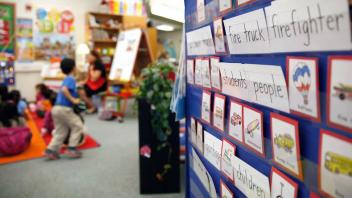How can I help my students learn words indirectly?
You can encourage indirect learning of vocabulary in two main ways. First, read aloud to your students, no matter what grade you teach. Students of all ages can learn words from hearing texts of various kinds read to them. Reading aloud works best when you discuss the selection before, during, and after you read. Talk with students about new vocabulary and concepts and help them relate the words to their prior knowledge and experiences.
The second way to promote indirect learning of vocabulary is to encourage students to read extensively on their own. Rather than allocating instructional time for independent reading in the classroom, however, encourage your students to read more outside of school. Of course, your students also can read on their own during independent work time in the classroom — for example, while you teach another small group or after students have completed one activity and are waiting for a new activity to begin.
What words should I teach?
You won’t be able to directly teach your students all the words in a text that they might not already know. In fact, there are several reasons why you should not directly teach all unknown words.
- The text may have a great many words that are unknown to students-too many for direct instruction.
- Direct vocabulary instruction can take a lot of class time — time that you might better spend on having your students read.
- Your students can understand most texts without knowing the meaning of every word in the text.
- Your students need opportunities to use word-learning strategies to learn on their own the meanings of unknown words.
You will probably to be able to teach thoroughly only a few new words (perhaps eight or ten) per week, so you need to choose the words you teach carefully. Focus on teaching three types of words: important words, useful words, and difficult words.
Words with multiple meanings are particularly challenging for students. Students may have a hard time understanding that words with the same spelling and/or pronunciation can have different meanings, depending on their context. Looking up words with multiple meanings in the dictionary can cause confusion for students. They see a number of different definitions listed, and they often have a difficult time deciding which definition fits the context. You will have to help students determine which definition they should choose. Click here for some examples of words with multiple meanings.
Idiomatic expressions also can be difficult for students, especially for students who are English language learners. Because idiomatic expressions do not mean what the individual words usually mean, you often will need to explain to students expressions such as “hard hearted,” “a chip off the old block,” “drawing a blank,” or “get the picture.”
How well do my students need to "know" vocabulary words?
Students do not either know or not know words. Rather, they know words to varying degrees. They may never have seen or heard a word before. They may have heard or seen it, but have only a vague idea of what it means. Or they may be very familiar with the meaning of a word and be able to use it accurately in their own speech and writing. These three levels of word knowledge are called:
- Unknown: the word is completely unfamiliar and its meaning is unknown
- Acquainted: the word is somewhat familiar; the student has some idea of its basic meaning
- Established: the word is very familiar; the student can immediately recognize its meaning and use the word correctly
As they read, students can usually get by with some words at the unknown or acquainted levels. If students are to understand the text fully, however, they need to have an established level of knowledge for most of the words that they read.
Are there different types of word learning? If so, are some types of learning more difficult than others?
Four different kinds of word learning have been identified:
- Learning a new meaning for a known word
The student has the word in her oral or reading vocabulary, but she is learning a new meaning for it. For example, the student knows what a branch is, and is learning in social studies about both branches of rivers and branches of government.
- Learning the meaning for a new word representing a known concept
The student is familiar with the concept but he does not know the particular word for that concept. For example, the student has had a lot of experience with baseballs and globes, but does not know that they are examples of spheres.
- Learning the meaning of a new word representing an unknown concept
The student is not familiar with either the concept or the word that represents that concept, and she must learn both. For example, the student may not be familiar with either the process or the word photosynthesis.
- Clarifying and enriching the meaning of a known word
The student is learning finer, more subtle distinctions, or connotations, in the meaning and usage of words. For example, he is learning the differences between running, jogging, trotting, dashing, and sprinting.
